
Individual racemes of 2-8 flowers develop from the axils of compound leaves; the peduncles of these racemes are about as long as, or a little shorter than, the length of the compound leaves. Each flower is about ½-¾" long, consisting of 5 petals with a pea-like floral structure, a tubular calyx with 5 teeth, several stamens, and a pistil with a single style. The petals consist of an upright banner and a pair of projecting wings that enclose the keel. These petals are mostly reddish purple; although the petals forming the keel and the base of the remaining petals are more pale. The banner has a network of purple veins. The calyx is reddish purple and mostly glabrous, although its teeth may be slightly ciliate along their margins. The blooming period occurs from late spring to mid-summer, lasting about 1 month. Afterwards, the flowers are replaced by elongated seedpods about 1-2½" long, ¼" across, and flattened. Each seedpod splits open into two valves to release its seeds. The small seeds are globoid in shape and somewhat flattened. The root system is fibrous and rhizomatous. At favorable sites, clonal colonies of plants often develop from the rhizomes.

Cultivation: The preference is full or partial sun, wet to moist conditions, and soil containing loam or sand. Standing water is tolerated if it is occasional, rather than permanent. In the absence of some kind of structural support, this vine will sprawl across the ground.
Range & Habitat: The native Marsh Pea is occasional in the northern half of Illinois, while in the southern half of the state it is rare or absent (see Distribution Map). More broadly, it has a circumboreal distribution, occurring in both North America and Eurasia. Habitats include wet prairies, interdunal swales, borders of marshes, fens, sedge meadows, low areas along streams, soggy thickets, and swamps. This wildflower occurs in both sandy and non-sandy habitats.
Faunal Associations: The flowers attract primarily bumblebees and other long-tongued bees that feed mostly on nectar. Other insects feed on foliage, flower tissues, or plant juices of Marsh Pea and other Lathyrus spp. These species include Acyrthosiphon pisum (Pea Aphid), caterpillars of the butterflies Everes comyntas (Eastern Tailed Blue) and Leptotes marina (Marine Blue), and Cerotoma trifurcata (Bean Leaf Beetle). In the past, the seeds of Lathyrus spp. were eaten by the extinct Passenger Pigeon.

Photographic Location: Moist sandy ground near a river at Illinois Beach State Park in Lake County, Illinois.
Comments: The typical variety of Marsh Pea (Lathyrus palustris palustris), as described here, has winged stems, narrow upright leaflets, and relatively dark reddish purple flowers. Mohlenbrock (2014) also describes another variety of Marsh Pea (Lathyrus palustris myrtifolius) that has stems without wings. Some authorities do not recognize distinct varieties, preferring to lump them together as a single species. This variety of Marsh Pea can be distinguished from other Lathyrus spp. (Vetchling species) by the number leaflets per compound leaf (typically 6 or 8), the shape and size of its stipules, the color of its flowers, and the number of flowers per raceme. Another species, Veiny Pea (Lathyrus venosus), differs from the typical variety of Marsh Pea by having more leaflets per compound leaf, wider leaflets, and more flowers per raceme. Non-native Lathyrus spp. (Vetchling species) in Illinois are quite distinct because they have only 2 leaflets per compound leaf.